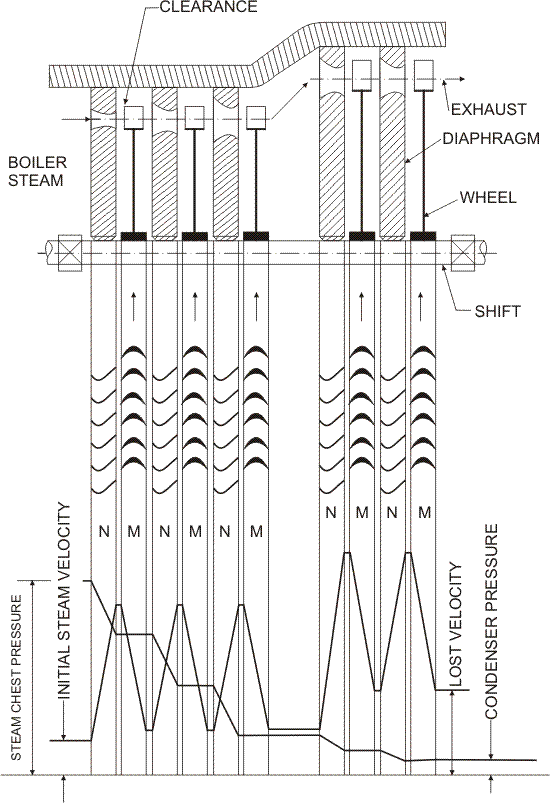Pressure Compounding or Rateau Staging
The Pressure - Compounded Impulse Turbine
To alleviate the problem of high
blade velocity in the single-stage impulse turbine,
the total enthalpy drop through the nozzles of
that turbine are simply divided up, essentially
in an equal manner, among many single-stage
impulse turbines in series (Figure 24.1). Such
a turbine is called a Rateau
turbine ,
after its inventor. Thus the inlet steam velocities
to each stage are essentially equal and due to
a reduced Δh.

Figure 24.1 Pressure-Compounded Impulse Turbine Pressure drop - takes place in more than one row
of nozzles and the increase in kinetic energy after
each nozzle is held within limits. Usually convergent
nozzles are used
We can write
 |
(24.1) |
 |
(24.2) |
where  is carry over coefficient is carry over coefficient
Reaction Turbine
A reaction turbine, therefore,
is one that is constructed of rows of fixed and rows
of moving blades. The fixed blades act as nozzles.
The moving blades move as a result of the impulse
of steam received (caused by change in momentum)
and also as a result of expansion and acceleration
of the steam relative to them. In other words, they
also act as nozzles. The enthalpy drop per stage
of one row fixed and one row moving blades is divided
among them, often equally. Thus a blade with a 50
percent degree of reaction, or a 50 percent reaction
stage, is one in which half the enthalpy drop of
the stage occurs in the fixed blades and half in
the moving blades. The pressure drops will not be
equal, however. They are greater for the fixed blades
and greater for the high-pressure than the low-pressure
stages.
The moving blades of a reaction turbine are easily
distinguishable from those of an impulse turbine
in that they are not symmetrical and, because they
act partly as nozzles, have a shape similar to that
of the fixed blades, although curved in the opposite
direction. The schematic pressure line (Fig. 24.2)
shows that pressure continuously drops through all
rows of blades, fixed and moving. The absolute
steam velocity changes within each stage as shown
and repeats from stage to stage. Figure 24.3 shows
a typical velocity diagram for the reaction stage.
Figure 24.2 Three stages of reaction turbine indicating pressure and velocity distribution Pressure and enthalpy drop both in the fixed blade or stator and in the moving blade or Rotor
Degree of Reaction =  |
or,  |
(24.3) |
A very widely used design has half degree of reaction or 50% reaction and this is known as Parson's Turbine. This consists of symmetrical stator and rotor blades.
Figure 24.3 The velocity diagram of reaction blading
The velocity triangles are symmetrical and we have
Energy input per stage (unit mass flow per second)
 |
(24.4) |
 |
(24.5) |
From the inlet velocity triangle we have,
Work done (for unit mass flow per second) 
 |
(24.6) |
Therefore, the Blade
efficiency
 |
(24.7) |
|